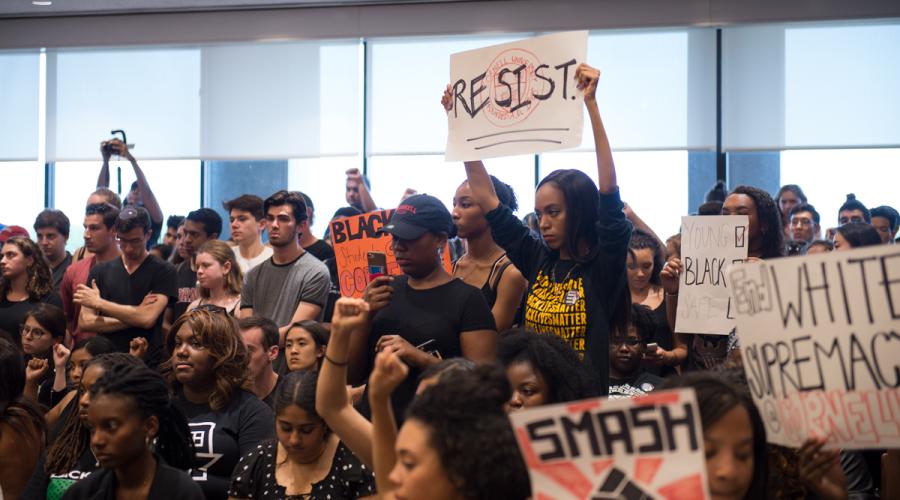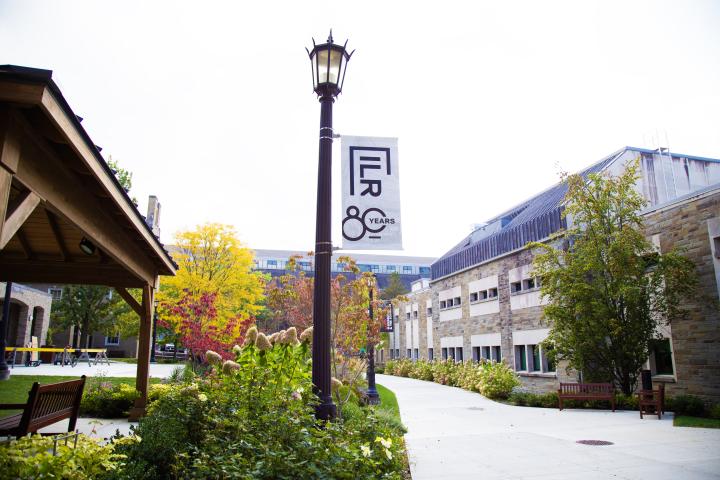
Students Respond to Hate with Movement Building
Summary of the Incident(s)
In the early hours of September 15th, a young black student was hospitalized after being physically and verbally assaulted by members of the unrecognized Psi Upsilon fraternity. Friends and witnesses that stepped in to help the student were also subject to hateful speech and actions. Using a host of racial slurs, the fraternity members were reportedly heard saying that they “own this school,” an allusion to Psi Upsilon alumni, many of whom have made significant financial contributions to the school and/or sat on the university’s Board of Trustees.
Earlier that month on September 5th, members of the Zeta Psi fraternity were reportedly heard shouting “build a wall around the LLC” following the Trump administration’s decision to end the Deferred Action for Childhood Arrivals (DACA) policy. The LLC, or Latino Living Community, was founded in 1994 and serves as a program house for students that “share a common interest in Latino/a culture, history, and current events.” Zeta Psi is their next-door neighbor.
Incidents of bias are not new to Cornell’s campus. In 2016 alone, there were 7 reported hate crimes by campus security authorities and other law-enforcement agencies. Three of these seven were hate crimes motivated by race. In a climate where not all students feel safe, meaningful institutional and cultural reform must take place to address the campus and societal norms that perpetuate problematic power structures and leave some students with more protection than others. Recent history at Cornell has shown that black and brown bodies are disproportionately the targets of racial epithets delivered by white perpetrators. Students have continuously expressed concern at their ability to walk alone at night in Collegetown, with incidents such as bottle throwing stirring doubt. In response to the incidents in September, various student organizations have taken to social media, news outlets, and the campus to express their outrage, concern, and willingness to assist university administration in creating effectual campus reform. Featured below are excerpts from official statements released by student organizations in response to the assault on September 15th.
Black Students United at Cornell University (BSU)
“The aftermath of the incident on Friday serves to remind the black population at this school that we are nothing but tokens, paraded around yet never protected. What occurred was not only assault, but also theft— a young, hopeful black man was robbed of his dignity, safety, and identity. As Cornell finds the meaning of words arbitrary to their real meanings, the phrases attributed to the young Black man became transposed by his ‘Brothers.’ ‘Frat brother’ became ‘Other,’ ‘Deserving’ became ‘Degraded,’ and “Cornell student,” became ‘N****r’.”
“No one in the Cornell community should feel unsafe or threatened on this campus. As leaders, we will speak out against such incidents — no matter where they occur, or who they impact. Now more than ever, we’re committed to be a fighting force against bias and discrimination.”
The Greek Tri-Council released a comprehensive Diversity and Inclusion Plan shortly after publishing their first statement. The plan is anchored in values of “accountability, education, impact, and change.”
“We, La Asociación Latina, stand in solidarity with Black Students United at Cornell University and the Black Community. [...] This is, as we’ve stated before, a deeply ingrained cultural issue within Greek life. This is not free speech. This is not freedom of expression. This is hate in its most volatile form.”
South Asian Council (SAC)
“We do not want to just see a list of mental health resources available on campus. We do not want to hear about dialogue, because if dialogue was enough, the Greek system would be diverse, equitable, and proactive. [...] The Greek system is repeatedly held unaccountable for their actions, whether it is hazing, sexual assault, substance abuse, discrimination or some other form of violence. This is a system that perpetuates and continues to uphold misogyny, homophobia, and racism, under the guise of superficial morals of brotherhood, friendship, and service.”
Cornell Asian Pacific Islander Student Union (CAPSU)
“When we enter Cornell, the University promises an intellectually aggressive education and engagement with ‘diverse perspectives’– it is unfortunate that not more of us are surprised that the aggression ultimately comes in the form of violence against people based on their race, gender, sexuality, and/or religion. It is sad that it takes these incidents for the University to think about what is to be done to challenge oppressive systems that nurture racism, when students for decades have been forced to think about what is to be done (and then do what is needed to be done) in order to survive.”
“The Student Assembly calls upon IFC and the Panhellenic Council to explain and justify the existence of an institution that perpetuates racism, elitism, and sexual violence, and whose monetary influence silences the administration. We call upon the administration to explain and justify the prioritization of white supremacy through the existence of fraternities over the safety of their students.”
The statements above were circulated widely on e-mail listservs, as well as on Facebook, which disseminated news of September’s racially-charged incidents to other universities and media outlets. An article relating the events at Cornell was published in The New York Times on September 18th.
In addition to online mobilization strategies, students, with Cornell BSU taking the helm, initiated a series of campus demonstrations. On September 19th, BSU led a silent rally at the University Assembly meeting, defying expectations that students would be rowdy and clamorous. On September 20th, students walked with BSU to Day Hall to silently hand deliver a list of demands to President Martha Pollack. The crowd then migrated to Willard Straight Hall and occupied the historical student union building for several hours. At every event, students were encouraged to wear all black as a sign of solidarity.
These student campus demonstrations and social media actions made clear to the Cornell community that injustice and discrimination would be met with strong resistance from students of color and their allies on campus. These mobilizations demonstrate the potential of intersectional movement building at Cornell. In the coming weeks, allied students will continue to seek redress from university administration, waiting in the wings for an action-oriented plan that examines and tackles the root causes of inequality on campus.


